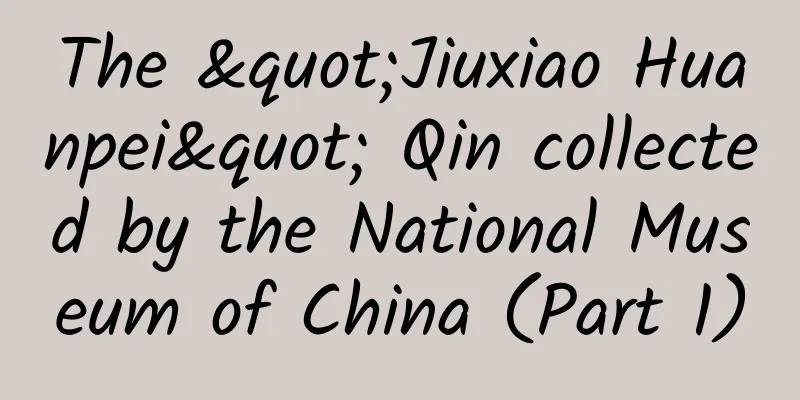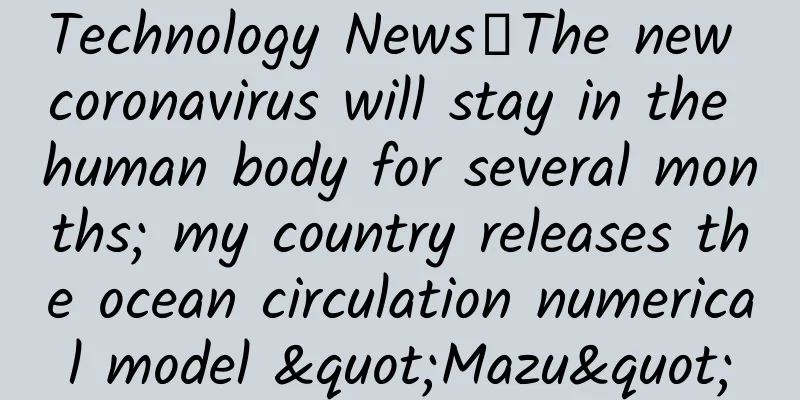The "Jiuxiao Huanpei" Qin collected by the National Museum of China (Part 1)

|
The "Jiuxiao Huanpei" Qin collected by the National Museum of China (Part 1) Scholars of Lü Zhi Culture The National Museum of China (hereinafter referred to as "National Museum") has a Tang Dynasty zither "Jiuxiao Huanpei", which is a national first-class cultural relic and is a typical Fuxi style. According to the inscription on the bottom of the zither, this zither was originally collected by Feng Zhen of the Northern Song Dynasty. It was later identified by Zhou Bida, a connoisseur and collector of the Southern Song Dynasty, as a "Lei Qin" from the Tang Dynasty. However, compared with the Tang Dynasty zither "Jiuxiao Huanpei" in the collection of the Palace Museum in Beijing, which is regarded as a "famous Tang object" and "immortal product", the "Jiuxiao Huanpei" in the National Museum is not very well-known. [Tang Dynasty] "Jiuxiao Huanpei" Qin Fuxi style Collection of the National Museum of China The "Jiuxiao Huanpei" Qin in the National Museum The "Jiuxiao Huanpei" zither in the National Museum is in the Fuxi style. The zither surface is made of paulownia wood and the zither bottom is made of zelkova wood. The zither body is 123.5 cm long, 23 cm wide at the shoulder, 15 cm wide at the tail and 5.6 cm thick. The original lacquer was black, but it has faded completely, and the color is like chestnut shells, with red ground exposed where the lacquer has faded. The clam emblem is made of gray deer antlers, and the whole body has snake-like belly and cow-hair broken patterns. The dragon pond is round, the phoenix pond is oblong, and the sound is slightly raised. The goose feet and the zither pegs are made of red agate. There are ink writings in the belly of the zither, but unfortunately they are blurred and cannot be recognized. The four-character name of the zither "Jiuxiao Huanpei" is engraved in large seal script on the neck of the bottom of the zither and above the dragon pond. The name of the zither is "Jiuxiao Huanpei" In addition to the name of the zither, there are also inscriptions in cursive script by Zhou Bida of the Southern Song Dynasty on the left and right sides of the dragon pool, totaling 65 characters, with vigorous strokes, flying momentum, and exquisite engraving. The text is recorded as follows: Lei carved it, and it started in Kaiyuan. Feng treasured it, and I don't know how many generations it has been passed down. I am not a connoisseur of music, but I can talk about the principle. The heart is in control, and the hand responds to the string. Therefore, the sound harmony can be raised up to the horse, and the mind kills the body to catch the cicada. Is it only this? When it is big, it sings "Southern Wind", and when it is small, it is to prepare the father of the child. All of them are not beyond this. The signature reads "Written by Zhou Bida, an old man from Pingyuan, in April of the first year of Jiatai (1512)." Zhou Bi Da's inscription in cursive script A seal with the words "中和之氣" in seal script is engraved on the lower part of the dragon pool. Seal with the Chinese character “中和之氣” The "Jiuxiao Huanpei" zither has a vigorous, simple and solemn atmosphere, neat craftsmanship, ancient structure and excellent seal inscriptions. Around 1980, this zither was played by zither players such as Wu Jinglue and Li Xiangting, who all praised it highly. The inscription on the bottom of the zither, written by Zhou Bida, is recorded in Zhou's Pingyuan Xugao, named "Feng Zhen Yuan Fang Qin Ming", and included in Wen Zhong Ji. The inscription on the bottom of the zither is exactly the same as the inscription on the bottom of the zither, so it can be concluded that this zither was originally owned by Feng Zhen of the Northern Song Dynasty. On the Xinchou day of April in the first year of Jiatai (1201) of the Southern Song Dynasty, Zhou Bida identified it as made by a member of the Lei family, a famous zither maker in Western Shu during the Tang Dynasty, and wrote a postscript to record it. Feng Zhen (birth and death years unknown), courtesy name Fufang, was the great-nephew of Feng Jing, a famous minister during the reign of Emperor Renzong. He was a Jinshi in the third year of Yuanfu (1100) during the reign of Emperor Zhezong. He served as the chief clerk of Xinchang County, Ruizhou Prefecture, Jiangxi Province, and the prefect of Jiande Prefecture. From the ninth year of Shaoxing (1139) to the tenth year (1140), he served as the prefect of Yanzhou, Zhejiang Province. Feng was fond of collecting throughout his life, including bronze Yi artifacts, calligraphy and painting, steles and rubbings, and ancient zithers. Zhou Bida (1126-1204), courtesy name Zichong and another courtesy name Hongdao, called himself Pingyuan Laosou. Originally from Guancheng, Zhengzhou (now Zhengzhou, Henan), his ancestors lived in Luling, Jizhou (now Ji'an, Jiangxi). He was a famous politician and writer in the Southern Song Dynasty and one of the "Four Loyalists of Luling". In the 21st year of Shaoxing (1151), he passed the imperial examination and became a Jinshi. In the 27th year of Shaoxing (1157), he passed the examination for erudition and eloquence. He served in local positions many times and was promoted to Minister of Personnel, Privy Councilor, and Left Prime Minister. He was granted the title of Duke of Xu. In the first year of Qingyuan (1195), he retired as Grand Secretary of Guanwendian and Duke of Yiguo. In the fourth year of Jiatai (1204), he died in Luling and was awarded the title of Grand Master. In the third year of Kaixi (1207), he was given the posthumous title of "Wenzhong" and Emperor Ningzong personally wrote the "Monument of Loyalty, Wen, and Virtue". Zhou Bi Da was skilled in writing poetry and was the leader of the literary world in the middle period of the Southern Song Dynasty. He had frequent contacts with famous writers such as Lu You, Fan Chengda and Yang Wanli. Zhou Bida was fond of books and history throughout his life. He was "profound in source and flow, and he was familiar with all nine schools and seven theories". He wrote many works, including 200 volumes of political commentaries, diaries, four-six essays, and 81 kinds of works. He was also "in the Hanyuan for nearly six years, and his edicts were gentle and elegant, and he was comprehensive in all matters. His poems and essays were the best of the time." The officials of the Qing Dynasty's Siku Library gave high praise to Zhou Bida's articles: (Zhou) Bi Da was recognized by Emperor Xiaozong for his writings. His edicts were gentle and elegant, and his style was broad and profound. He was the best of the imperial court after the Southern Migration. He was also very meticulous in textual research and was well-known for his time. His rich writings were unmatched by anyone except Yang Wanli and Lu You. Zhou Bida was born into a family of scholars. His grandfather Zhou Shen was a Jinshi in the third year of Yuanfu (1100) during the reign of Emperor Zhezong of the Song Dynasty. In the first year of Jingkang (1126), he served as the deputy governor of Jizhou Luling, and his family settled here. His father Zhou Lijian and his uncle Zhou Lijian both passed the Jinshi exam in the eighth year of Zhenghe (1118) during the reign of Emperor Huizong of the Song Dynasty. It was a good story that two people from the same family passed the Jinshi exam. His father Zhou Lijian was good at calligraphy and liked to collect. Under the influence of family education, Zhou Bida showed extraordinary talent in calligraphy since he was a child. When he was over 20 years old, he could write for his uncle to deal with the worldly affairs. In the following decades, whenever he saw various famous calligraphy works, paintings, inscriptions, ancient artifacts and other treasures, Zhou Bida liked to write a postscript. In this regard, Zhou Bida also said that he was "not a continuationist" and that his postscript could add a lot of color to the treasures. According to historical records, Zhou Bida's grandfather Zhou Shen and Feng Zhen were both Jinshi in the same year. As their ancestors served in the same dynasty, it was natural for Feng Zhen's descendants to bring their ancestors' collections to Zhou Bida, who was famous in the academic world, to appreciate and write inscriptions. In addition to the "Jiuxiao Huanpei" zither, Feng Zhen's collection of treasures that were appreciated and inscribed by Zhou Bida also included five calligraphy scrolls by Su Dongpo, Mi Fu, and Huang Tingjian, namely "Dongpo Calligraphy of the Stele of Fu Wenzhonggong", "Dongpo Calligraphy of Tao Jingjie's Poems", "Dongpo Calligraphy of Yingzhou Poems", "Mi Yuanzhang Calligraphy to Lü Jigong", and "Shan Gu Calligraphy of Mr. Liuyi's Ancient Fu". According to research by Mr. Wang Zhiqiang and Mr. Xin Lihua of the National Museum of China, the "Jiuxiao Huanpei" zither was originally a collection of the Shandong Provincial Museum. In 1959, it was transferred to the National Museum of Chinese History (the predecessor of the National Museum of China) through the State Administration of Cultural Heritage. Later, it was identified as a national first-class cultural relic by Mr. Shi Shuqing and others, and was filed and stored. However, there is no record of the circulation of the zither before it was collected by the Shandong Provincial Museum. Qian Zai (1708-1793), a poet, calligrapher and painter during the Qianlong period of the Qing Dynasty, once recorded in his "Collection of Poems from the Poetry Collection of Shishizhai" that he had seen the same "Leiqin" with Zhou Bida's postscript inscribed in the homes of collectors named Lu and Weng, and wrote a poem "Song of the Leiqin Inscribed by Zhou Wenzhonggong" to record it. What is even more gratifying is that Qian Zai copied the inscription of this "Leiqin" into the volume. After checking, the inscription is exactly the same as the inscription on the bottom of the "Jiuxiao Huanpei" qin in the National Museum. Therefore, the "Leiqin" seen by Qian Zai is very likely the "Jiuxiao Huanpei" qin in the National Museum. In addition, in Qian Zai's account, the four characters "Kaiyuan Guichou" were "engraved" in eight-part script in the dragon pool of the "Leiqin" he saw, and were arranged on the left and right. According to the records, "Kaiyuan Guichou" was the first year of the Kaiyuan reign of Emperor Xuanzong of the Tang Dynasty (713). Most of the inscriptions on the dragon pools of ancient guqins seen today are written, and the way Qian Zai recorded the "engraving" of the year in the dragon pool is relatively rare. It is suspected that the record is wrong, or it is "ink writing". A detailed examination of the "Jiuxiao Huanpei" guqin in the National Museum of China found ink writing inside the belly, but unfortunately it is blurred and cannot be distinguished. If the "Jiuxiao Huanpei" guqin is the same guqin that Qian Zai saw, then the ink writing should be "Kaiyuan Guichou" without a doubt. The inscription on the "Jiuxiao Huanpei" zither in the National Museum of China only says "Lei made it", but Zhou Bida is not sure who Lei was. According to the cultural relic identification file of the zither, Mr. Shi Shuqing and others speculated that the zither might have been made by Lei Haiqing, a court musician who resisted An Lushan's rebellion during the reign of Emperor Xuanzong of Tang. However, this speculation is not supported by any real evidence and is not credible. According to the "Lei Qin Ge" by Li Diaoyuan of the Qing Dynasty, the zithers made by the famous zither makers of the Lei family in Western Shu have their own names, which are generally: Lei Wei created the word "pine snow" and Lei Xiao created the sound of "pine wind". The famous spring "Yujian" was cut by Lei Xun, and the famous spring "Jiuxiao Yu (Huan) Pei" was cut by Lei Wencheng. The other two, Lei Sheng and Lei Jue, are none other than "Ling Kai" and "Bing Qing". If this theory is true, it can be inferred that the "Jiuxiao Huanpei" zither in the National Museum's collection must have been made by Lei Wen. |
<<: Don't tear off the sticker on the bottom of the thermos cup!!! Otherwise...
Recommend
Does the human's "secret weapon" also have a "bug"? Monkeys, please don't blindly worship "walking upright"!
Primates, including humans, apes, monkeys, etc., ...
The key method of excellent creative advertising!
Those advertisements that seem creative and amazi...
Beijing is issuing tens of millions of yuan worth of movie tickets. How to claim and use them?
Where can I get the movie tickets worth 10 millio...
User growth: How to achieve distribution fission?
The development of the Internet has passed the tr...
How much does it cost to develop a Taizhou home furnishing mini program? What is the price for developing a home furnishing app in Taizhou?
Taizhou Home Furnishing Mini Program Development ...
Baidu promotion video information flow advertising display style - Feed post-patch
Information flow advertising style - Post-feed pa...
Lanzhou Mini Program Financial Functions, What Should We Pay Attention to When Developing Mini Programs?
Nowadays, the development of the financial market...
The Universe is Expanding! Is Time Passing Faster Now Than in the Early Universe?
In July 2023, two astronomers from the University...
Honeywell responds to unqualified mask inspection (with original text)
Honeywell responds to unqualified mask sampling (...
iOS 17.5 released, sideloading is finally here!
Early this morning, Apple pushed the first beta s...
Practical Tips | Things to do to improve conversion rate (Part 1)
User motivation and resistance analysis When user...
Tik Tok practical operation notes!
Tik Tok is a new world, and every world has its o...
China Automobile Dealers Association: Analysis of vehicle data for the first week of September 2023
In the first week of September 2023, there were 1...
Ledgers, Hounds, and Boars
Wang Youqin lost confidence in farming after thre...
Xpeng Motors' new progress in autonomous driving, obtains California autonomous driving license
Recently, documents from the California Departmen...









